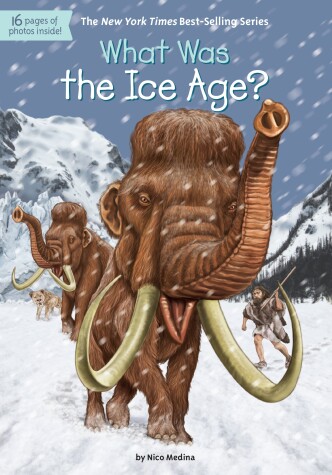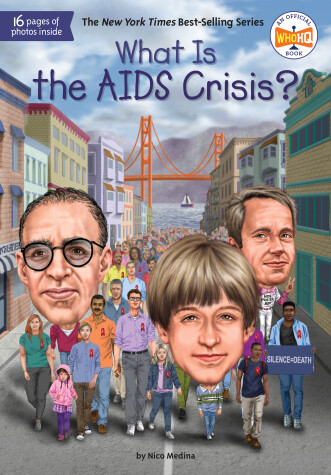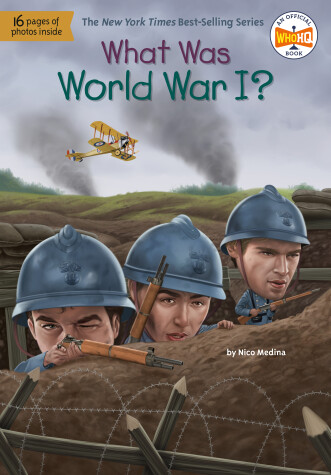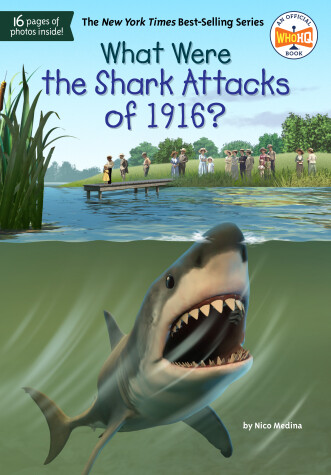What Was...?
6 total works
A mesmerizing overview of the world as it was when glaciers covered the earth and long-extinct creatures like the woolly mammoths and saber-toothed cats battled to survive.
Go back 20,000 years ago to a time of much colder global temperatures when glaciers and extensive sheets of ice covered much of our planet. As these sheets traveled, they caused enormous changes in the Earth's landscape and climate, leading to the evolution of creatures such as giant armadillos, saber-toothed cats, and woolly mammoths as well as club-wielding Neanderthals and later the cleverer modern humans. Nico Medina re-creates this harsh ancient world in a vivid and easy-to-read narrative.
Go back 20,000 years ago to a time of much colder global temperatures when glaciers and extensive sheets of ice covered much of our planet. As these sheets traveled, they caused enormous changes in the Earth's landscape and climate, leading to the evolution of creatures such as giant armadillos, saber-toothed cats, and woolly mammoths as well as club-wielding Neanderthals and later the cleverer modern humans. Nico Medina re-creates this harsh ancient world in a vivid and easy-to-read narrative.
In 1961, overnight a concrete border went up, dividing the city of Berlin into two parts - East and West. The story of the Berlin Wall holds up a mirror to post-WWII politics and the Cold War Era when the United States and the USSR were enemies, always on the verge of war. The wall meant that no one from Communist East Berlin could travel to West Berlin, a free, democratic area. Of course that didn’t stop thousands from trying to breech the wall - more than one hundred of them dying in the attempt. (One East Berliner actually ziplined to freedom!) Author Nico Medina explains the spy-vs-spy politics of the time as well as what has happened since the removal of one of the most divisive landmarks in modern history.
In the early-morning hours of June 28, 1969, police arrived at the Stonewall Inn’s doors and yelled, “Police! We’re taking the place!” But the people in this New York City neighbourhood bar, members of the LGBTQ community, were tired of being harassed. They rebelled in the streets, turning one moment into a civil rights movement and launching the fight for equality among LGBTQ people in the United States.
In this addition to the New York Times bestselling series, learn how incredible activists made the public aware of AIDS and spurred medical breakthroughs.
In the early 1980s, the first cases of a devastating and fatal new disease appeared, a disease that at first struck only gay men and was later identified as HIV/AIDS. It was the beginning of what became a worldwide health crisis that the US government ignored for years and that unfairly heightened prejudice against the LGBTQ+ community. To this day, the AIDS Crisis continues to disproportionately affect both the LGBTQ+ community and people of color. Nico Medina has written an accurate and affecting history of a terrible time, spotlighting the heroic efforts of AIDS activists who fought for medical research and new medicines, for proper health care for patients, and for compassionate recognition of people with AIDS.
In the early 1980s, the first cases of a devastating and fatal new disease appeared, a disease that at first struck only gay men and was later identified as HIV/AIDS. It was the beginning of what became a worldwide health crisis that the US government ignored for years and that unfairly heightened prejudice against the LGBTQ+ community. To this day, the AIDS Crisis continues to disproportionately affect both the LGBTQ+ community and people of color. Nico Medina has written an accurate and affecting history of a terrible time, spotlighting the heroic efforts of AIDS activists who fought for medical research and new medicines, for proper health care for patients, and for compassionate recognition of people with AIDS.
In 1914, the assassination of an Austrian archduke set off a disastrous four-year-long conflict involving dozens of countries with battles taking place in all parts of the world. World War I was the first to use planes and tanks as well as deadly gases that left soldiers blinded or “shell shocked” (a condition now called Post Traumatic Stress Syndrome). There were battles that lasted for months with opposing troops fighting from rat-infested trenches, battles that often ended in a hollow victory with only a small area of land retaken. The author of many successful Who HQ titles Nico Medina gives young readers a clear and compelling account of this long and tragic event, a war that left over 20 million dead and was the lead-up to World War II barely twenty years later.
The panic-filled summer of 1916, when multiple deadly shark attacks shocked the nation, is chronicled in this gripping addition to the New York Times Best-Selling What Was? series.
On July 1, 1916, witnesses watched in horror as twenty-eight-year-old Charles Vansant was attacked and killed by a shark in shallow water off Beach Haven, New Jersey—the first recorded shark attack in American history. Scientists claimed a shark could not be responsible, but more deadly attacks soon followed along the Jersey Shore and up the freshwater Matawan Creek, setting off a nationwide panic that led the White House to declare a “War on Sharks.” In this illustrated book, which features 16 pages of black-and-white photographs, readers will learn about the likely culprit (or culprits) in the attacks—the great white shark and the bull shark—and how the bloody summer of 1916 would change how people viewed sharks forever.
On July 1, 1916, witnesses watched in horror as twenty-eight-year-old Charles Vansant was attacked and killed by a shark in shallow water off Beach Haven, New Jersey—the first recorded shark attack in American history. Scientists claimed a shark could not be responsible, but more deadly attacks soon followed along the Jersey Shore and up the freshwater Matawan Creek, setting off a nationwide panic that led the White House to declare a “War on Sharks.” In this illustrated book, which features 16 pages of black-and-white photographs, readers will learn about the likely culprit (or culprits) in the attacks—the great white shark and the bull shark—and how the bloody summer of 1916 would change how people viewed sharks forever.





